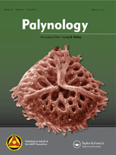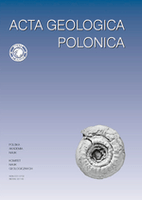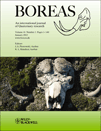
PALYNOLOGY
Scope & Guideline
Deciphering Climate Changes Through Ancient Pollens
Introduction
Aims and Scopes
- Pollen Morphology and Taxonomy:
Research focusing on the morphological characteristics of pollen grains as a means to identify plant species and understand their taxonomic relationships. - Palynostratigraphy:
Studies aimed at establishing the chronological sequence of sedimentary layers based on the distribution of palynomorphs, contributing to geological and paleoclimatic reconstructions. - Paleoecology and Environmental Reconstruction:
Investigations that utilize palynological data to reconstruct past environments and climate conditions, providing insights into ecological changes over geological time. - Melissopalynology:
Research that examines pollen content in honey to understand bee foraging behavior and the ecological dynamics of pollinator-plant interactions. - Biostratigraphy of Dinoflagellates and Acritarchs:
Focus on the classification and stratigraphic significance of dinoflagellate cysts and acritarchs, contributing to the understanding of marine and freshwater ecosystems through different geological periods. - Human Impact Studies:
Explorations of how human activities have altered palynological records, impacting vegetation and biodiversity in various regions.
Trending and Emerging
- Climate Change and Ecological Responses:
A growing number of studies are focusing on the impacts of climate change on pollen distribution and vegetation dynamics, emphasizing the role of palynology in understanding contemporary ecological shifts. - Applications of Advanced Imaging Techniques:
The use of cutting-edge techniques, such as scanning electron microscopy and confocal laser scanning microscopy, in pollen analysis is on the rise, providing deeper insights into pollen morphology and its implications for taxonomy. - Palynology in Agroecosystems:
Emerging research is increasingly examining the interactions between pollen sources and agricultural practices, including the foraging behavior of bees and other pollinators in agroecosystems, highlighting the importance of biodiversity in food production. - Paleoenvironmental Studies using High-Resolution Data:
There is an increasing trend in utilizing high-resolution palynological data to reconstruct detailed paleoenvironmental conditions, reflecting a shift towards more nuanced and precise reconstructions of past climates and ecosystems. - Interdisciplinary Approaches:
Recent publications show a trend towards integrating palynology with other scientific disciplines, such as molecular biology, ecology, and environmental science, enhancing the multidisciplinary nature of palynological research.
Declining or Waning
- Traditional Palynological Techniques:
There has been a noticeable decrease in papers emphasizing traditional methods of palynological analysis, such as basic morphological descriptions, as researchers increasingly adopt advanced imaging techniques and molecular methods. - Nomenclature Debates:
Although nomenclature issues were once a significant topic within the journal, recent publications indicate a reduced emphasis on debates surrounding taxonomic naming conventions and nomenclatural updates. - General Flora Surveys:
The prevalence of broad surveys of local flora based solely on palynological analysis appears to be declining, possibly due to the increasing preference for studies that integrate molecular data and ecological assessments.
Similar Journals

BIOLOGIA
Connecting researchers to the forefront of biological discovery.BIOLOGIA, a distinguished journal published by Springer, serves as a pivotal resource in the fields of biological sciences, including Animal Science, Zoology, Plant Science, Ecology, Evolution, Behavior, Cell Biology, Biochemistry, and Genetics. Established in 1954 and continuously disseminating knowledge through its converged years until 2024, it supports the academic community by fostering effective communication amongst researchers and professionals. Notably, the journal boasts a commendable presence in academic rankings, holding a Q2 ranking in Animal Science and Zoology, along with Q3 designations in multiple disciplines, reflecting its substantial impact in enhancing scientific inquiry. While currently not offering open access, the journal remains a critical tool for those seeking to stay at the forefront of biological research, supported by its robust publication framework. For students, researchers, and professionals alike, BIOLOGIA is an essential reference for innovative studies and findings that drive the field forward.

JOURNAL OF THE PALAEONTOLOGICAL SOCIETY OF INDIA
Exploring Evolutionary Insights from the Indian SubcontinentThe JOURNAL OF THE PALAEONTOLOGICAL SOCIETY OF INDIA, published by SAGE PUBLICATIONS INDIA PVT LTD, stands as a significant resource in the field of paleontology, dedicated to disseminating high-quality research and findings from the Indian subcontinent and globally. With an ISSN of 0552-9360, this journal has established itself within the academic community, particularly as it converges its publication years from 2011 to 2024. Ranking in the Q4 category of paleontology as of 2023, it serves an essential niche for researchers and students interested in the historical biological records and evolutionary processes. Despite its current Scopus ranking of #88 out of 113 in the Earth and Planetary Sciences category, the journal plays a pivotal role in fostering scholarly dialogue and advancing the understanding of paleontological sciences in India and beyond. Researchers are encouraged to contribute to this evolving field and share their findings, solidifying the journal's commitment to highlighting significant paleontological research contributions.

PALEOBIOLOGY
Advancing Insights into Earth's Biological PastPALEOBIOLOGY, published by Cambridge University Press, is a premier, peer-reviewed journal that stands at the forefront of research in paleontological sciences. With a robust commitment to advancing the study of the interactions between ancient life forms and their environments, the journal has established itself as a vital resource for researchers, professionals, and students in the fields of paleontology, ecology, and evolutionary biology. Spanning from 1975 to 2024, it boasts an impressive Q1 ranking in several categories, including Agricultural and Biological Sciences, Ecology, and Paleontology, indicative of its high impact and relevance in shaping contemporary scientific discourse. While the journal is not open access, it offers a variety of subscription and access options, ensuring broad distribution and visibility of published research. As a leader in its discipline, PALEOBIOLOGY aims to facilitate a deeper understanding of our planet's biological history, making it an essential publication for anyone interested in the dynamics of life across geological time.

NAUTILUS
Unraveling the Mysteries of Aquatic EcosystemsNAUTILUS is a distinguished journal published by the Bailey-Matthews Shell Museum, dedicated to advancing the understanding of aquatic sciences as well as ecology, evolution, behavior, and systematics. With an ISSN of 0028-1344, NAUTILUS has played a significant role in the scholarly community from its inception, with publication converged between 1996 to 2015 and 2017 to 2024. Although currently categorized as Q4 in Aquatic Science and Ecology, Evolution, Behavior and Systematics for 2023, the journal has a reputation for publishing high-quality research that contributes to the broader scientific discourse. Researchers and students alike can benefit from the insights provided by NAUTILUS, which remains committed to exploring the intricate relationships within aquatic ecosystems. Its editorial management, led by Dr. José H. Leal, ensures rigorous peer review and academic excellence, making it a crucial resource for those dedicated to discovering the complexities of aquatic and ecological research.

ACTA GEOLOGICA POLONICA
Innovative research shaping the landscape of geology.ACTA GEOLOGICA POLONICA is a distinguished journal published by the Polska Akademia Nauk, in collaboration with the University of Warsaw's Geology Department. Since its inception, it has served as a vital platform for disseminating innovative research in the field of Geology, reflecting a commitment to advancing scientific knowledge in Earth and planetary sciences. With an ISSN of 0001-5709 and an E-ISSN of 2300-1887, this journal provides a rigorous review process and is classified in the Q3 quartile for Geology as of 2023, indicating its growing influence in the discipline. Despite not being open access, the journal facilitates meaningful contributions that span a range of geological topics from fundamental research to applied sciences, thereby enriching the academic landscape. Researchers, professionals, and students alike are encouraged to engage with the valuable findings and discussions contained within its pages, which continue to shape the future of geological inquiry.

BULLETIN OF GEOSCIENCES
Illuminating the Intersections of Geology and EnvironmentBULLETIN OF GEOSCIENCES, published by the prestigious Czech Geological Survey, stands as a pivotal resource in the fields of Earth and Planetary Sciences and Environmental Science. Since its inception in 2003, the journal has been committed to advancing knowledge through high-quality research, currently holding a commendable Q2 ranking in both disciplines. With its focus on diverse and innovative topics, BULLETIN OF GEOSCIENCES provides an essential platform for researchers, professionals, and students aiming to disseminate and access impactful studies. The journal is indexed in Scopus, ranking #78/195 in General Earth and Planetary Sciences and #110/233 in General Environmental Science, reflecting its significant contribution to academia. Publishing from Prague, Czech Republic, this journal invites contributions that illuminate the interactions between geological processes and environmental phenomena, ensuring an inclusive and accessible approach to crucial global issues.

BOREAS
Elevating Academic Discourse in Geology and EvolutionBOREAS is a prestigious academic journal published by WILEY, dedicated to advancing knowledge across the fields of Archaeology, Ecology, Evolution, Behavior, Systematics, and Geology. With a commendable track record since its inception in 1972, BOREAS has consistently contributed to the scholarly landscape, currently holding a distinguished position in Q1 across multiple categories, including a ranking of #8 in Archaeology and a solid percentile rank in Ecology and Geology. This high-impact journal fosters the dissemination of groundbreaking research, further establishing itself as a vital resource for researchers, professionals, and students alike. While access options are limited to subscription-based, the quality and significance of research published in BOREAS make it an essential addition to any academic library, ensuring that studies conducted in these pivotal fields reach a global audience. With a commitment to excellence and innovation, BOREAS continues to drive forward the frontiers of knowledge and understanding in Earth and planetary sciences.

ACTA BIOLOGICA CRACOVIENSIA SERIES BOTANICA
Advancing plant science through rigorous research.ACTA BIOLOGICA CRACOVIENSIA SERIES BOTANICA is a distinguished journal published by the Polska Akademia Nauk (Polish Academy of Sciences), with its roots tracing back to 1996. As a pivotal publication in the field of Plant Science, it serves to disseminate high-quality research and findings, contributing to the ongoing development and understanding of biodiversity, plant ecology, and conservation. The journal is indexed under Scopus, ranked #203 out of 516 in its category, placing it in the 60th percentile and firmly within Q3 quartile for Plant Science in 2023. Researchers, professionals, and students will find invaluable content within its pages, enhancing their knowledge and supporting academic exploration. Although it currently does not offer open access options, the journal remains a crucial resource for those engaged in botanical sciences, with a commitment to advancing scholarship in Poland and beyond.

AMEGHINIANA
Illuminating the Past: Insights into Ecology and PaleontologyAMEGHINIANA is a distinguished academic journal published by the ASOCIACION PALEONTOLOGICA ARGENTINA, serving as a vital platform for the dissemination of cutting-edge research in the fields of Ecology, Evolution, Behavior and Systematics, as well as Paleontology. With its ISSN 0002-7014 and E-ISSN 1851-8044, the journal has established itself as a key reference point for scholars seeking to explore the intricate relationships within ecological systems and the evolutionary history of species. Despite not offering open access, AMEGHINIANA maintains a reputation bolstered by a Q3 ranking in both its subject categories, underlining its sustained commitment to enhancing scientific knowledge. Researchers and professionals alike benefit from this journal’s extensive archive of studies dating back to 1985, with ongoing contributions expected until 2024. With a focus on high-quality content, this journal is essential for anyone immersed in the study of paleobiology and ecological systems.

JOURNAL OF PALEONTOLOGY
Unearthing the Secrets of Ancient LifeJOURNAL OF PALEONTOLOGY, published by Cambridge University Press, is a leading scholarly journal dedicated to the field of paleontology, featuring a broad scope that covers fossil studies, evolutionary biology, and earth history. With an ISSN of 0022-3360 and an E-ISSN of 1937-2337, this esteemed journal serves as an essential platform for researchers, professionals, and students to disseminate cutting-edge research findings and insights in paleontological science. The journal holds a significant position within its category, ranking Q2 in the 2023 quartiles and achieving a Scopus rank of #51 out of 113 in Earth and Planetary Sciences – Paleontology, placing it in the 55th percentile of its field. Although it does not currently offer open access options, JOURNAL OF PALEONTOLOGY has been a critical contributor to advancing knowledge from its inception in 1979 through to 2024. Its dedication to rigorous research ensures it remains an indispensable resource for those vested in the understanding of ancient life and ecosystems.